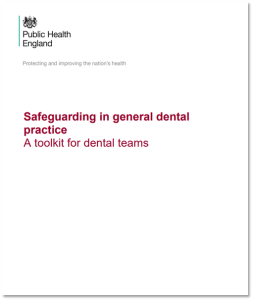Safeguarding in General Dental Practice

Safeguarding is everyone’s responsibility, and the onus is on all professionals to be observant to safeguarding risks, to be able to recognise and respond to abuse and neglect, and to promote the safety and wellbeing of all children and young people. As part of their routine day-to-day work dentists will come across children and young people, some of whom will be vulnerable to, or victims of abuse and neglect. The dentists, and dental staff may be the ones who recognise evidence of neglect, and therefore they need to be aware of what to do with their concerns.
The guidance on this page is designed to help dental practices and dentists ensure that they have robust safeguarding arrangements in place and that staff have access to appropriate guidance and training.
The British Dental Association (BDA) states that dental teams have an ethical responsibility to find out about local safeguarding procedures for adults, children and young people and to follow them if they are or might be at risk of abuse or neglect (Standards for the Dental Team. GDC, 2013).
https://www.bda.org/advice/Pages/safeguarding.aspx
Safeguarding Guidance
Organisational responsibility for safeguarding is set out in the HM Government statutory guidance: Working Together to Safeguard Children 2018. All professionals who come into contact with children must give due regard to the guidance:
https://www.gov.uk/government/publications/working-together-to-safeguard-children–2
Public Health England have published a comprehensive safeguarding toolkit for dental teams. The guidance sets out the responsibilities of individuals and how to identify and respond to the main types of abuse and neglect.
The WSCP website sets out what to do if professionals have concerns about children and young people:
https://www.wirralsafeguarding.co.uk/concerned-about-a-child/
Referral to Dental Care for CLA
Social Workers should complete the following form for children looked after they wish to refer for dental care:
Referral to Dental Care for CLA
Expectations for Training
The following guidance gives a dental specific summary of the expectations for training from the Royal College of Nursing on the roles and competencies for safeguarding adults, children and young people. The roles and competencies apply to both NHS and private providers in all settings in which dentistry is practised:
All new starters should have a mandatory safeguarding induction (children and adults) for a minimum of 30 minutes within the first six weeks of taking up the post.
The RCN expectations are outlined below:
|
Dentist inc orthodontists |
Person with Specific safeguarding responsibilities |
Hours of refresher training over 3 years: |
|
Level 2 |
Level 2 |
minimum 4 hours + annual review of competencies |
|
Practice Manager |
Receptionist and other non-clinical staff |
Hours of refresher training over 3 years: |
|
Level 2 |
Level 2 |
minimum 2 hours + annual review of competencies |
The majority of dentists and dental care professionals will require level 2.
In larger organisations, including hospitals and community-based specialist services (special care dentistry, paediatric or other relevant dental specialties such as orthodontics) the precise number of dentists and dental care professionals requiring level 3 competencies should be determined locally based on an assessment of need and risk.
Under these circumstances, the following levels are required:
|
Practice Manager |
Receptionist and other non-clinical staff |
Hours of refresher training over 3 years: |
|
Level 2 |
Level 2 |
minimum 2 hours + annual review of competencies |
|
Dentist with specific role in safeguarding |
DCP with specific role in safeguarding |
Hours of refresher training over 3 years: |
|
Level 3 |
Level 3 |
minimum 8 hours + annual review of competencies |
The WSCP provides a variety of training which can be accessed by dental staff. At a minimum the named safeguarding lead should attend the following courses at least every three years:
- Working Together to Safeguard Children
- Managing Allegations
We would also strongly recommend that the practice manager/ and or the safeguarding lead also attend Safer Recruitment training at least every five years.
Details of these courses, and the other courses offered by the WSCP are here (registration required to access the training)
Expectations of the WSCP
The WSCP strongly recommends that dental practices have the following in place to demonstrate robust safeguarding arrangements:
- A named safeguarding lead
- A written commitment to safeguarding children (visible in the practice)
- A statement of safeguarding and or a policy which sets out what staff should do if they have concerns
- Evidence that all staff have attended a safeguarding induction
- Evidence staff have attended an annual safeguarding awareness raising session
- Evidence the safeguarding lead has attended specific safeguarding training (e.g. Working Together) every 3 years
- Participation in the WSCP’s Section 11 annual safeguarding self-audit. Details here.
Further Information
BDA – Implementing ‘Was Not Brought’ policy in your practice
Do you see what I see? Identification of child protection concerns by hospital staff and general dental practitioners
Working Together to Safeguard Children – multi-agency statutory guidance
RCN -Safeguarding Children and Young People: Roles and Competencies for Healthcare Staff

